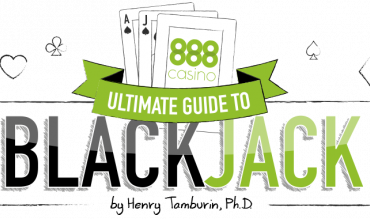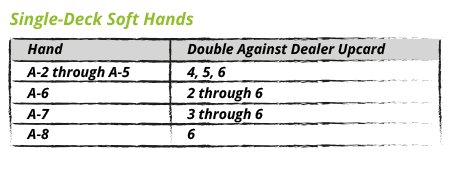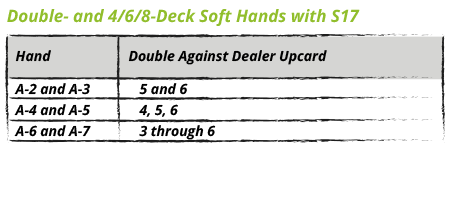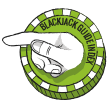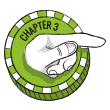BLACKJACK BASIC STRATEGY

strategies for blackjack. Topics covered include:
- What exactly is the “blackjack basic playing strategy,” and why is it so important.
- The basic strategy rules for surrendering a hand.
- The basic strategy rules for splitting a pair.
- The basic strategy rules for doubling down hard and soft hands.
- The basic strategy rules for hitting and standing.
- Insurance and even money.
IMPORTANCE OF BASIC BLACKJACK STRATEGY
of playing blackjack. Don’t believe it’s possible to do this?
At the end of this section I’ll show how this is possible.
BLACKJACK QUIZ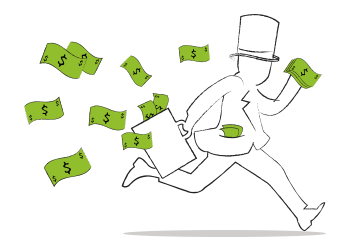
The first step to become a skillful player is to learn the basic blackjack playing strategy. Many players believe they know the basic strategy and how to play blackjack. It’s been my experience that beginning players, who are serious about learning how to win, are usually enthusiastic about wanting to learn basic strategy. Experienced players, on the other hand, scoff at reading or learning about basic strategy because, “They know that stuff.” Well, if you are an “experienced player,’’ let’s see how much you really know about blackjack basic strategy. Jot down how you would play these hands; unless otherwise stated, assume a standard 6-deck game, dealer stands on soft 17, and doubling down after pair splitting is permitted. ![]()
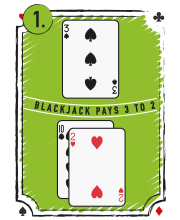
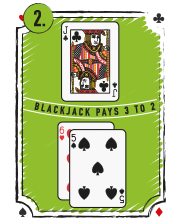
the dealer shows a 10.
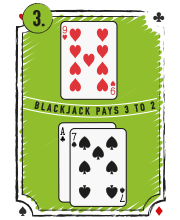
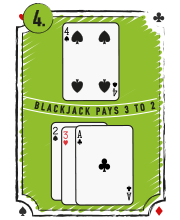
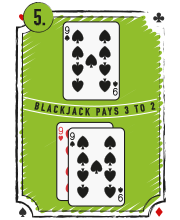
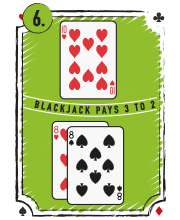
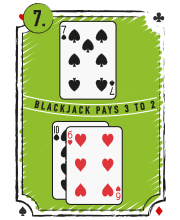
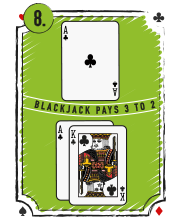
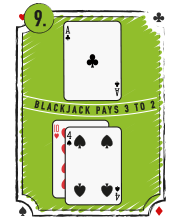
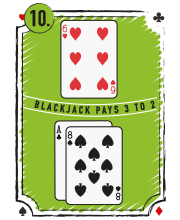
THE CORRECT BASIC BLACKJACK STRATEGY PLAYS FOR THE ABOVE HANDS IN ORDER ARE:

If you got some wrong, don’t fret, because the majority of blackjack players, even experienced players, flunk this quiz, which is why casinos continue to profit from a game that theoretically can be beaten.
BOTTOM LINE
The basic playing strategy is a set of rules that tells you the optimal way to play every hand dealt to you when the only information you have is your hand and the dealer’s upcard. Basic strategy is the mathematically correct way to play every hand because over time it will maximize the amount of money you will win and minimize the amount you will lose. The reason that the game of blackjack is subject to mathematical analysis is because it is, inherently, a mathematical game; that is, blackjack has a fixed set of rules.
CASINOS’ EDGE
In Chapter 1, I showed you how you can reduce the casinos’ edge in blackjack to about 0.2–0.5% (rule dependent) by knowing the correct playing decisions (i.e., the basic playing strategy). A half percent house edge in dollars and cents means the casino will win, on average, fifty cents for every $100 you bet. This is, by far, a less costly game to play when you compare the loss per $100 wager to other casino games:
- Bank hand in baccarat is $1.06
- Pass line at craps is $1.41
- Playing double zero roulette is $5.26.
Of course, you can do better than losing 50 cents per hundred dollars bet at blackjack and in future chapters I’ll show you how.
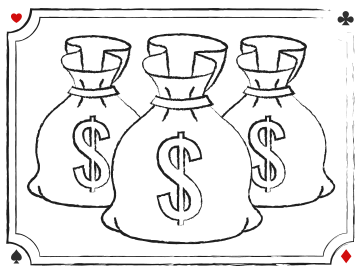
SAVING $80,000
Here’s a quick story that I hope will reinforce my point about why it’s so critical and important that you learn the basic playing strategy.
Let’s assume twin brothers Jack and Joe, in their long lifetime of gambling, will each play 10,000 hands of blackjack per year, for 50 years, assuming 100 hands per hour, and 100 hours of blackjack per year. Their average bet will be a modest $10 per hand, playing a typical six-deck blackjack game where the dealer stands on soft 17, and double down after pair splitting is allowed. In all, they will each wager $5 million. Jack never bothers to learn the basic playing strategy, so he plays by intuition. Over his lifetime, Jack is expected to lose about $100,000 at the blackjack tables, assuming a disadvantage of about 2%.

Jack’s twin brother, Joe, takes a different course of action. He spends a little time and learns the basic playing strategy. He also brings along a basic strategy card when he plays, so if he is not sure how to play a hand, he glances at his card for guidance. By playing basic strategy perfectly, Joe expects to lose about $20,000 over his lifetime, assuming a disadvantage of 0.4%. Compared to his twin brother, Jack, Joe saved $80,000.

If I paid you $80,000 to learn basic strategy, would you do it? Of course, you would. And that’s exactly my point; namely, memorizing the basic playing strategy has real value over your lifetime of playing blackjack. So, let’s get started on learning how to play every hand perfectly.
![]()
BLACKJACK SURRENDER STRATEGY
It turns out that using the blackjack surrender option properly is actually a very smart play to make on some hands compared to an alternative play of, say, hitting or standing. For the uninitiated, surrender works like this:
After considering your initial two-card hand and the dealer’s upcard, if you think your chance of winning the hand is very poor, you can forfeit playing your hand and surrender (or give up) half of the amount of your wager. You indicate to the dealer when you want to surrender in one of two ways:
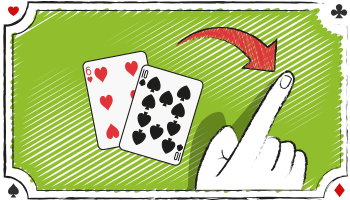
- In some casinos, you must verbally announce to the dealer that you want to surrender your hand by saying “surrender.”
- Other casinos have implemented a hand signal for surrender, which is to draw an imaginary line from left to right on the felt with your index finger.
Either way, if you decide to surrender your hand, the dealer will remove half of your bet then scoop up your initial two cards and place them in the discard tray. Essentially, when you surrender, you forfeit the right to play out your hand and you immediately lose half of your bet.
THERE ARE TWO TYPES OF BLACKJACK SURRENDER: LATE SURRENDER AND EARLY SURRENDER.
![]()
LATE BLACKJACK SURRENDER
With late surrender, you can only surrender your hand after the dealer peeks at her hole card when she shows an ace or a ten, to determine if she has blackjack. If she has blackjack, the surrender option is no longer available, and you will lose your entire bet unless you also have a blackjack. When you use late surrender correctly, it will reduce the house edge by about 0.07 percent in multiple-deck games.
The basic strategy for late surrender is summarized below in a black and white table followed by a color-coded strategy chart, for all games.
BASIC STRATEGY - LATE SURRENDER
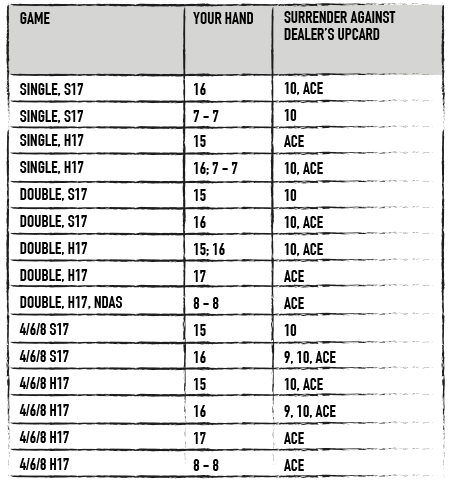
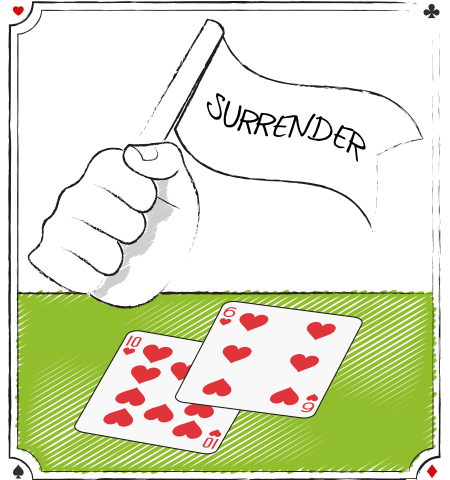
![]()
SINGLE DECK WITH SOFT 17
Dealer’s Upcard 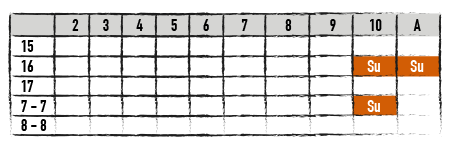
SINGLE DECK WITH HARD 17
Dealer’s Upcard 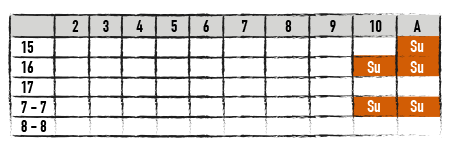
![]()
DOUBLE DECK WITH SOFT 17
Dealer’s Upcard 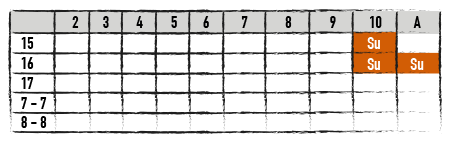
DOUBLE DECK WITH HARD 17
Dealer’s Upcard 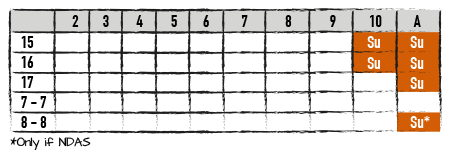
![]()
4/6/8 DECKS WITH SOFT 17
Dealer’s Upcard 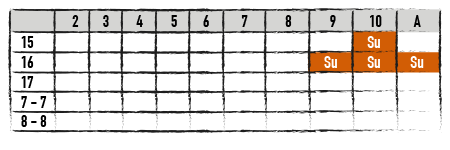
4/6/8 DECKS WITH HARD 17
Dealer’s Upcard 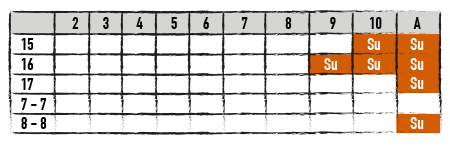
![]()
EXAMPLES OF HOW TO USE THE BLACKJACK BASIC STRATEGY
- Single-deck game with hard 17, you hold 16, dealer’s upcard is a 10. You should surrender.
- Double-deck game with soft 17, you hold 15, dealer’s upcard is an ace. You should hit (surrender only against dealer’s 10).
- Six-deck game with soft 17, you hold 16, dealer’s upcard is a 9. You should surrender.
- Six-deck game with hard 17, you hold 8-8, dealer’s upcard is an ace. You should surrender.
![]()
EARLY SURRENDER
Early surrender is rarely offered in U.S. casinos and is more prevalent in European and Asian casinos where dealers do not take a hole card until after all players have acted on their hands (so-called European no-hole-card rule, which I will cover in more detail in Chapter 13). With the early surrender option, players can surrender their hand to a dealer’s ace and/or ten-value upcard before the dealer checks to determine if she has a blackjack. Early surrender is a much more favorable rule for players than late surrender. Early surrender against the ace gains you 0.39 percent, and against the 10, it’s 0.24 percent, making the total value to the player 0.63 percent for a six-deck s17 game.
STRATEGY FOR EARLY SURRENDER
The basic playing strategy for early surrender in a multiple-deck game (soft 17) is different than the strategy for late surrender.
When early surrender is offered, you should surrender these hands:
- Against a dealer ace, surrender hard 5 to 7 (including 3s), and 12 to 17 (including 6s, 7s, and 8s).
- Against a dealer ten, surrender hard 14 to 16, including 7s and 8s.
- Against a dealer 9, surrender hard 10-6 and 9-7 (but not 8s).
Note that in some European and Asian (especially Macau) casinos, you can only early surrender against a dealer’s ten upcard not against the ace.
MATH OF SURRENDER
You should surrender a hand when your chance of winning is less than one out of four hands, i.e., your expected loss is worse than 50%. This means that statistically, if playing the hand has less than a 25 percent chance of winning and consequently greater than a 75 percent chance of losing, you will save money in the long run by surrendering the hand instead.
MODERATING NEGATIVE SWINGS
Besides reducing the house edge, surrender also has this benefit: it will stabilize your bankroll, meaning surrender will flatten the fluctuations in your bankroll, compared to a game where surrender is not offered and you have to play all your hands to completion.
Additional Tips
- Many casinos that offer surrender don’t advertise it; therefore, don’t be afraid to ask the floor person or dealer if it’s available.
- Don’t be surprised if your fellow players look at you like you are some kind of kook when you surrender.
Most novice players and even some casino supervisors think that giving up half of your bet and throwing in the hand is a stupid play. Pay no attention to their stares or comments — you’ll be making the right play and saving more of your profits in the long run.
![]()
![]()
BLACKJACK PAIR SPLITTING STRATEGY
They either never split, or they always split, or in the worst case, they recklessly split pairs with no rhyme or reason.
This is unfortunate because pair splitting was introduced into the game as a way for players to reduce the casino's advantage. But in reality an option meant to help the player has turned out to be a money maker for the casino.
Every time I observe a recreational player splitting tens (which is an awful play), I visualize a big casino cash register going cha-ching. But it doesn't have to be like this. In fact, by the time you finish reading this section you will learn when and why to split pairs so that you can use this option efficiently to win more money when you play blackjack.
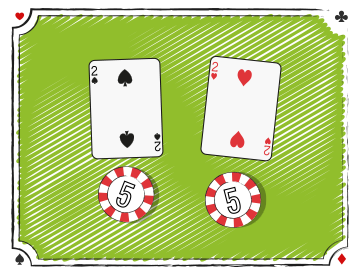 CASINO BLACKJACK RULES FOR PAIR SPLITTING
CASINO BLACKJACK RULES FOR PAIR SPLITTING
The casino rules for pair splitting are pretty straightforward. When you are dealt two cards of the same value, you may split them into two separate hands. For example, if you bet $5 and receive a pair of 2s, you have a single hand totaling 4. You could play the hand as a 4 and draw additional cards or you could split the 2s into two hands. You activate the pair splitting option by placing another equal bet next to the original bet on the layout. If your original bet was $5, then you would place another red chip on the layout. Do not place your chip(s) on top of the original wager — simply place it adjacent to your original bet. By doing this, you are signaling the dealer that you want to split your 2s, and play two hands. One hand has a $5 bet and contains a 2, ditto for the second hand. You must play out your first hand (to your right) before you are permitted to play out the second hand.
BASIC BLACKJACK STRATEGY FOR PAIR SPLITTING
The factors that determine the basic strategy for pair splitting are the number of decks of cards and the playing rules. Note: When casinos offer the more liberal DAS, you will be splitting more hands than when the rules specify NDAS. The basic strategy for pair splitting is shown below in a black and white table followed by a color-coded chart for single-, double-, and 4/6/8-deck games.
The black and white strategy table shows your pair in the first column and, in the second column, what the dealer’s upcard should be for you to split.
The color-coded chart shows the dealer’s upcard across the top and your pair along the left side. If the letter P (for Pair Split) is shown at the intersection of your pair and the dealer’s upcard that means you should split. Note: All pairs that should be split are highlighted with a blue background.
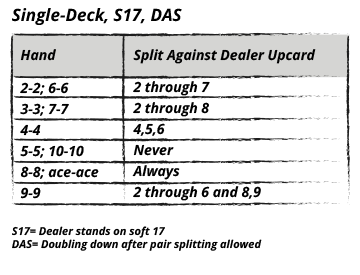
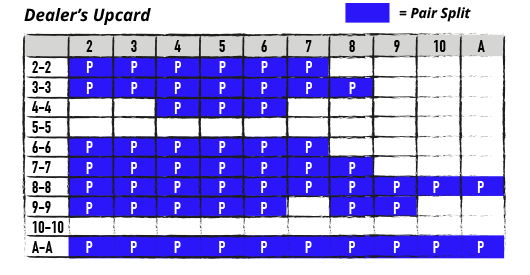
![]()
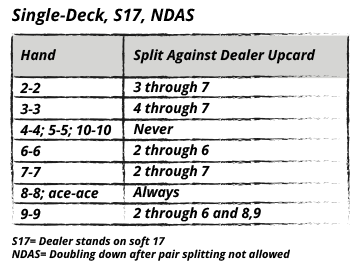
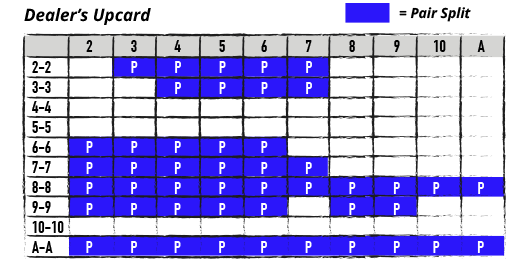
![]()
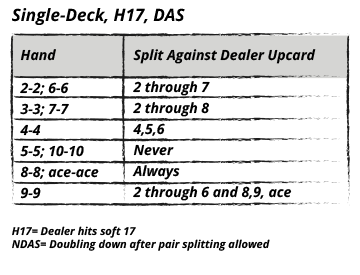
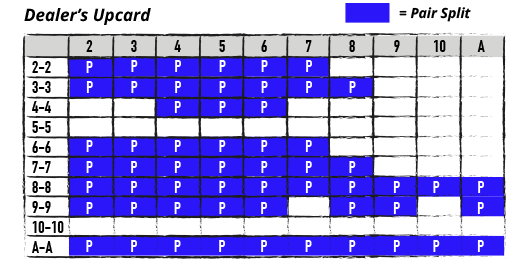
![]()
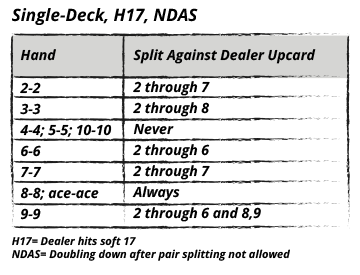
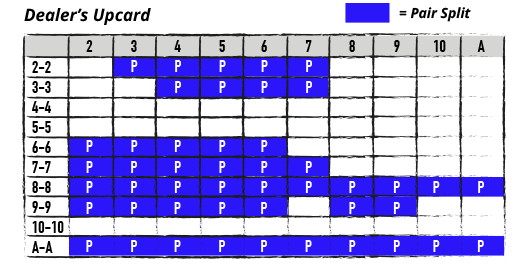
![]()
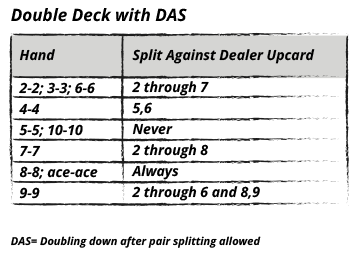
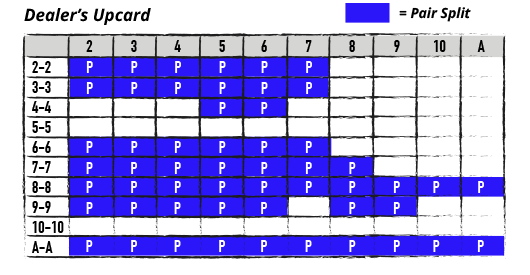
![]()
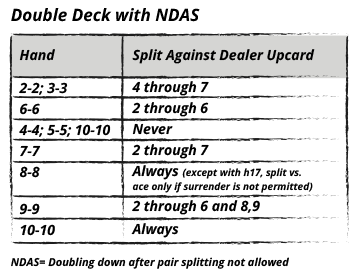
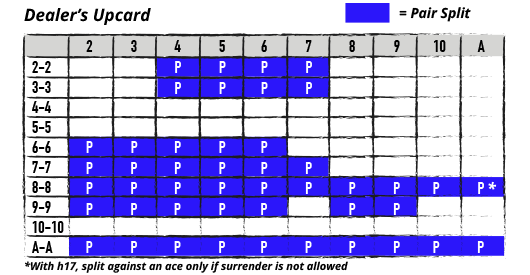
![]()
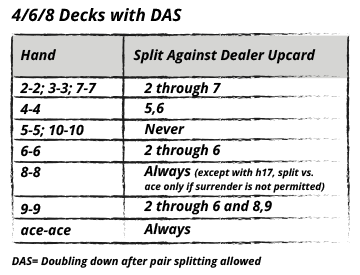
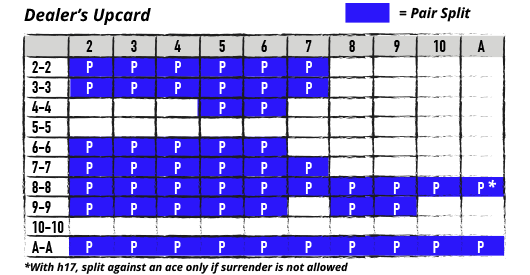
![]()
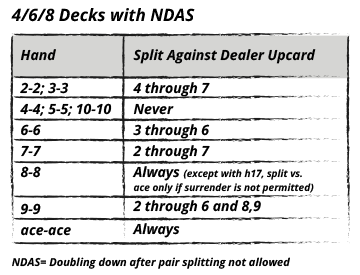
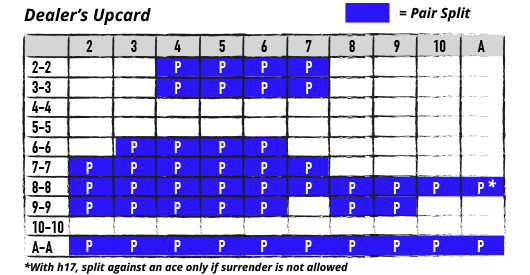
![]()
EXAMPLES OF HOW TO USE THE STRATEGY
- Single-deck game with NDAS, you hold 3-3 and the dealer’s upcard is a 7. You should split.
- Double-deck game with DAS, you hold 4-4 and the dealer’s upcard is a 5. You should split.
- Double-deck game with NDAS, you hold 4-4 and the dealer’s upcard is a 5. You should not split.
- Six-deck game with DAS, you hold 9-9 and the dealer’s upcard is a 9. You should split.
LOGIC FOR SPLITTING
There are three reasons why it makes sense to split rather than to employ an alternate strategy. You should always split when:
- You will win more money on average (bold strategy), or
- You will lose less money on average (defensive strategy), or
- You will turn a losing hand into a winning one (offensive strategy).
MATH OF PAIR SPLITTING
I’ll give a few examples of the math of pair splitting for the bold, defensive, and offensive pair splits.
BOLD BLACKJACK STRATEGY
A bold strategy means you are already the favorite to win money on a hand but if you split you'll win even more money. For example, suppose you are dealt a 9-9 against the dealer 6 upcard in a 6-deck, s17 game with NDAS, and resplits are allowed to a total of four hands. By standing, you can expect to win 64% of the hands and lose 36%. This means if you bet $1 per hand, playing this hand 100 times, you can expect an average profit per hand of ($64 – $36) divided by 100 = 28 cents.

If you split instead, the percentage of hands that you will win decreases slightly to 60% because you are better off starting with an 18 (9-9) against the dealer's 6, than starting with a single 9. If your winning percentage decreases when you split how can you win more? Because you have to take into consideration that you doubled your bet when you split. Your profit potential for both of the two hands together is 2 times ($60 – $40) divided by 100 = 40 cents. For every original $100 you bet on the 9-9 against the dealer 6 you stand to earn $12 more by splitting than by standing.

DEFENSIVE BLACKJACK STRATEGY
The defensive pair splitting strategy of betting more to cut your losses is confusing to players. All they remember is getting a weak pair, splitting them because the "book says so," and then losing both bets.
What they don't realize is that even though you will lose money over the long haul when you split pairs defensively, you will lose even more money on the hand if you don't split. Take the example of a pair of 7s against a dealer 2 upcard in a six-deck game with h27 and resplitting to a maximum of four hands. A 14, you'll agree, is a lousy hand. If you stand you can expect to win 36% of the time and lose 64%. Your net expected loss per hand is ($64 – $36)/100 = 28 cents. In other words, a 14 against a dealer's 2 is a losing hand if you stand, to the tune of 28 cents per hand.

Suppose instead you split the 7s. You start each hand with a 7, which is slightly better then a 14 against the dealer 2. But you are still the underdog even with the 7. You can expect to win 45% of the hands and lose 55%, and your average loss per hand comes to 10 cents, or 20 cents for the two hands. Yes, you are still going to lose money on the hand but which is better ... to lose 28 cents per hand by standing or 20 cents by splitting? I think you'll agree that splitting is the better play because you cut your losses by 8 cents.

OFFENSIVE BLACKJACK STRATEGY
Offensive pair splitting is often the most satisfying kind of splitting because you turn a losing hand into a winning one. Suppose, in an s17, multi-deck, NDAS game, you are dealt a pair of 7s, the dealer has a 6 upcard and you stand. A 14 is not a very good hand even against the dealer 6 upcard. You will win on average 42% of the hands (when the dealer busts) and lose 58% for a net loss of 16 cents per hand. By pair splitting, you start with a 7 on each hand, which is a stronger starting point than the 14. Therefore when you split you will win 52% of the hands and lose 48% for a 4 cent per hand (8 cents per pair split) profit. By splitting offensively you've turned the 16 cents per hand deficit into 8 cents per split profit, which is an overall gain of 24 cents.

![]()
Splitting pairs by the basic playing strategy allows you to turn potential losing hands into winners, earn more money on some splits, and lose less money on others. It’s an important strategy that you need to learn to reduce the house edge against you when you play blackjack.
![]()
BLACKJACK DOUBLING DOWN STRATEGY
Have you ever wondered how you can possibly break even or win at blackjack when overall you stand to win only about 47% (excluding ties) of the hands dealt to you? One reason is the double down option.
CASINO RULES FOR DOUBLING DOWN
When a casino allows you the option to double down, it means you can double the amount of your initial bet in return for receiving one, and only one, draw card; i.e., when you double down you give up the option of drawing more than one card. Most casinos allow you to double down on any two-card hand (hard or soft), whereas some restrict doubling to specific starting hands, e.g., doubling is allowed only on hard 10 and 11. The best player-friendly doubling rules are when you can double down on any two cards.
The two variables that determine whether or not you should double down are the total of the cards in your hand and the dealer’s upcard. As a general rule, the hands you are most likely to double are hard 8, 9, 10, and 11, and the soft 13 (A-2) through 18 (A-7) hands.
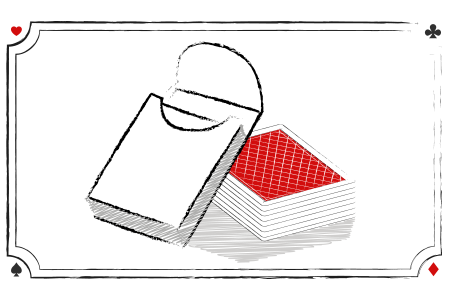
BASIC STRATEGY FOR SINGLE DECK
The following black and white tables and color-coded chart summarize the doubling down basic strategy for:
- Single-Deck Hard Hands
- Single-Deck Soft Hands
- Single-Deck Pairs
- Single-Deck colored chart containing all of the above
Single-Deck Hard Hands (but not 4-4)
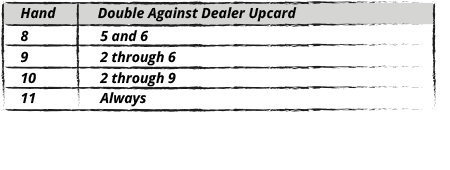
Single-Deck Pairs

Single-Deck Doubling Down Colored Chart
The following color-coded chart summarizes the basic strategy for doubling hard hands (including pairs) and soft hands for a single-deck game. 
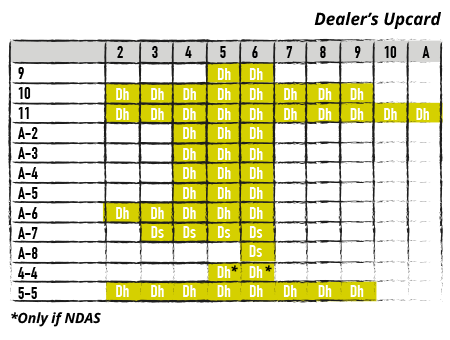
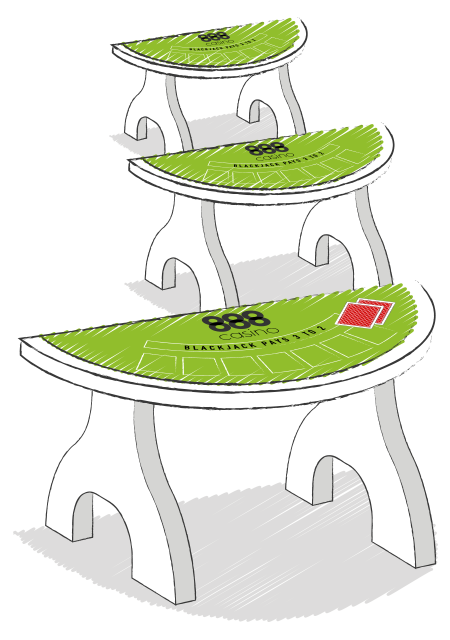
![]()
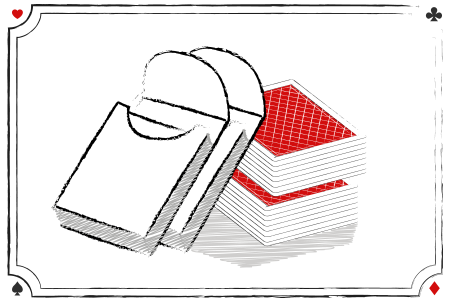 BASIC BLACKJACK STRATEGY FOR DOUBLE- AND 4/6/8-DECK
BASIC BLACKJACK STRATEGY FOR DOUBLE- AND 4/6/8-DECK
The following black and white tables and color-coded chart summarize the doubling down basic strategy for:
- Double- and 4/6/8-Deck Hard Hands
- Double- and 4/6/8-Deck Soft Hands with S17
- Double- and 4/6/8-Deck Soft Hands with h27
- Double- and 4/6/8-Deck Pairs
- Double- and 4/6/8-Deck colored chart containing all of the above
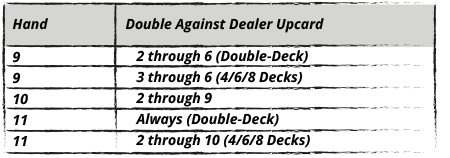
*If h27, double on 2 through Ace
Double- and 4/6/8-Deck Soft Hands with h27
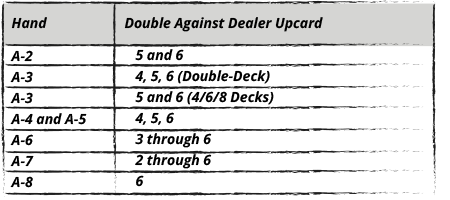
Double- and 4/6/8-Deck Pairs

The following color-coded charts summarize the double down basic strategy for Double Deck and 4/6/8 Decks with S17, followed by Double- and 4/6/8-Deck with h27.

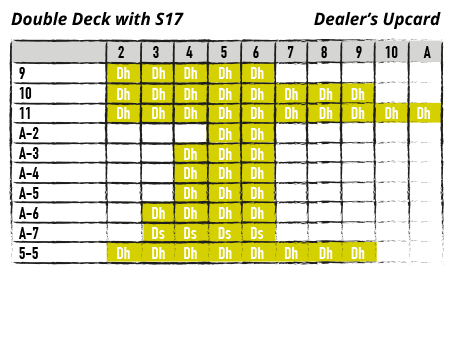
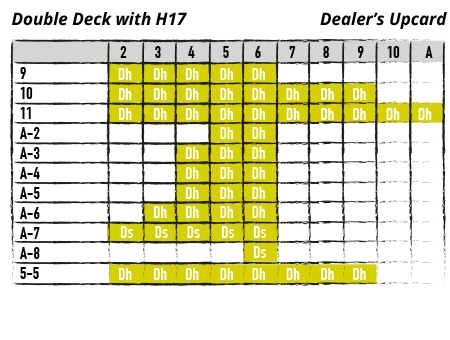
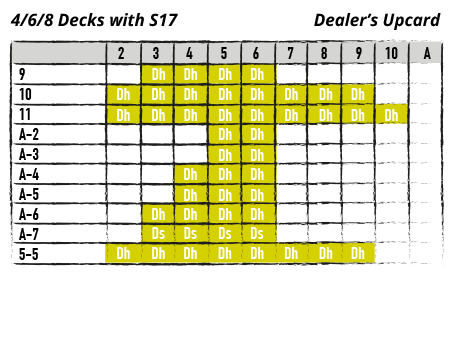
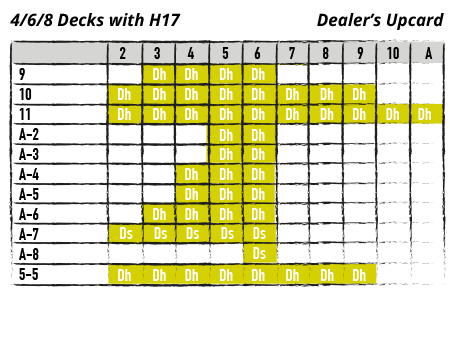
Examples of How to Use the Tables and Charts
- Single-deck game with h27, you hold 9 and the dealer’s upcard is a 2. You should double down.
- Double-deck game with h27, you hold A-8 and the dealer’s upcard is a 6. You should double-down.
- 4/6/8-deck game with s17, you hold 7-4. Dealer shows an ace. You should not double down.
You would double 7-4 against an ace only in single- and double-deck games.
LOGIC FOR DOUBLING DOWN ON HARD HANDS
Most of the time when you play blackjack you must play defensively because the dealer’s hand has a likelihood of beating your hand. But the logic for doubling down is you get to go on the offensive at the best possible time - when the dealer has a relatively high probability of busting or when you have the edge over the dealer on the hand.
LOGIC FOR DOUBLING ON SOFT HANDS
The logic for doubling on soft hands isn’t always clear to players so they often pass up the opportunity. The reason you double on soft hands is not so much to outdraw the dealer as it is to get more money on the table when the dealer is vulnerable to busting (shows a low-value upcard of 2-6).
GAINS FROM HARD AND SOFT DOUBLING
If you follow the hard doubling down basic strategy, your gain will be about 1.3 percent. Learn when to double down on soft hands and you’ll gain another 0.13 percent.
REDUCING YOUR CHANCES OF WINNING A HAND
What is ironic about doubling down is that with some hands, you will actually be reducing your chances of winning the hand because you get only one draw card. Take a 6-3 against a dealer’s 5 upcard. If you doubled down and drew a 2 for an 11, the only way you could win the hand would be if the dealer busted. If you hadn’t doubled down, you could have drawn another card to your 11 and improved your chances of winning. Nevertheless the right play is to double down because of the extra money you put into action. Here’s why.
MATH OF DOUBLING
If you hit a two-card 9 you stand to win 59 percent of the hands and lose 41 percent of them. If you bet $1 per hand, playing this hand 100 times, you can expect an average profit per hand of $59 - $41 divided by 100 = 18 cents.

If instead you double down, you stand to win only 57% of the hands but at double the amount bet. Your net gain by doubling is ($57 - $43) times 2 (double bet) divided by 100 = 28 cents. That’s 10 cents more gained per hand over hitting, which is why doubling is the better strategy in this case.

DOUBLING ON THREE OR MORE CARDS
Some casinos allow players to double down on three or more cards. In other words, if you had a 5-3 and drew a 3 for an 11, you could double down after the third card was drawn. This rather rare option will give you another 0.2 percent gain.
DOUBLING DOWN FOR LESS
Some casinos allow players to double down for less. This means if you bet $10 on the hand you can double down for an amount less than $10. But it is not wise to do so because you will maximize your gain only when you maximize the permissible amount of your double-down bet.
Learning the doubling down basic strategy for hard and soft hands is important because it allows you to bet more when the likelihood of winning your hand is good. It’s a key playing strategy that allows you to reduce the casino’s edge when you play blackjack.
BLACKJACK HIT & STAND STRATEGY
As you will learn shortly (Chapter 4), the last decision you should make when choosing which strategy to implement with your hand is whether to hit or stand. In this section, I’ll cover the hitting and standing strategy for hard hands and soft hands
CASINO BLACKJACK RULES FOR HITTING AND STANDING
The most frequent playing decision that you will have to make is whether to hit or stand.
- Hitting means to ask for another card (sometimes referred to as “drawing another card”).
- Standing means you are satisfied with your hand and you don’t want any more cards.
- You can stand or hit on any hand that totals 21 or less.
- You must signal the dealer to indicate if you want to hit or stand.
- Use the correct signals when the cards are dealt face up vs. when they are dealt face down.
- In the process of taking a hit, if your hand exceeds a total of 21, you’ve busted and you automatically lose your bet.
- Once you signal to the dealer that you want to stand, that completes your hand for that round.
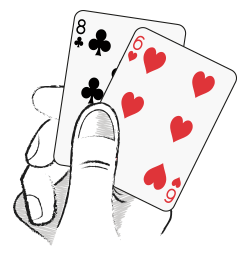 A FEW FACTS ABOUT HARD HANDS
A FEW FACTS ABOUT HARD HANDS
The worst hands you will get at blackjack are hard 12 through 17. The reason is that no matter what the dealer’s upcard happens to be, you stand to lose more hands than you will win in the long run. One exception: in an s17 game with two or more decks, a 17 vs. a 6 is a slight winner. In other words, virtually all these hands are overall losers for blackjack players. Surprised? Here’s one more gruesome statistic. You are going to be dealt one of these losers about 4 out of every 10 hands.
So what's a blackjack player to do when 40% of the time you are going to get a 12 through 17 whether you like it or not? Since you can’t change the cards that you are dealt, the best you can do is follow the basic playing strategy for hard (and soft) hands. You'll still take your lumps but you'll lose less money in the long run when you follow the basic strategy than if you depend upon divine intervention, or worse, play by the seat of your pants.
BASIC STRATEGY FOR HITTING AND STANDING
The following black and white tables and color-coded charts summarize the hitting and standing basic strategy for single-, double-, and 4/6/8-deck games. They assume that:
- Surrender is not available (if it is, follow the surrender strategy)
- You can double down on any two-card hand (following the doubling down strategy)
- If there are restrictions to hard or soft doubling, see the hitting and/or standing strategy.
The black and white tables and colored-coded charts contain the strategy for hitting and standing on hard hands, soft hands, and pairs for single-, double-, and 4/6/8-decks. The color-coded charts for single deck follow the black and white tables for single deck. Ditto for double deck and 4/6/8 decks. In total, there are nine black and white tables and nine color-coded charts containing the summary for hitting and standing for all games and rules.
Note: The hitting and standing strategies for hard and soft hands are not affected by DAS or NDAS, only whether the dealer stands on soft 17 (s17) or hits soft 17 (h27). Therefore the hitting and standing strategies below for hard and soft hands can be used with either DAS or NDAS. With pair splitting, the strategy is affected by DAS or NDAS, which is why there is one table and chart for pair splitting with DAS, and another with NDAS. Whether or not the dealer stands or hits on soft 17 will depend on the game in question. In most cases the rule will be printed on the table layout. h27 will increase the house edge by around 0.2%, compared to s17.
- Single Deck with S17, Hitting and Standing on Hard and Soft Hands
- Single Deck with S17 and DAS, Hitting and Standing on Pairs
- Single Deck with S17 and NDAS, Hitting and Standing on Pairs
- Single Deck with h27, Hitting and Standing on Hard and Soft Hands
- Single Deck with h27 and DAS, Hitting and Standing on Pairs
- Single Deck with h27 and NDAS, Hitting and Standing on Pairs
- Double Deck with S17, Hitting and Standing on Hard and Soft Hands
- Double Deck with S17 and DAS, Hitting and Standing on Pairs
- Double Deck with S17 and NDAS, Hitting and Standing on Pairs
- Double Deck with h27, Hitting and Standing on Hard and Soft Hands
- Double Deck with h27 and DAS, Hitting and Standing on Pairs
- Double Deck with h27 and NDAS, Hitting and Standing on Pairs
- 4/6/8 Decks with S17, Hitting and Standing on Hard and Soft Hands
- 4/6/8 Decks with S17 and DAS, Hitting and Standing on Pairs
- 4/6/8 Decks with S17 and NDAS, Hitting and Standing on Pairs
- 4/6/8 Decks with h27, Hitting and Standing on Hard and Soft Hands
- 4/6/8 Decks with h27 and DAS, Hitting and Standing on Pairs
- 4/6/8 Decks with h27 and NDAS, Hitting and Standing on Pairs
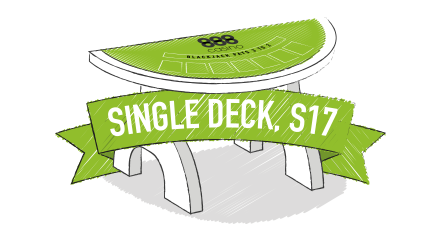
Single Deck, S17
Hitting and Standing Hard and Soft Hands
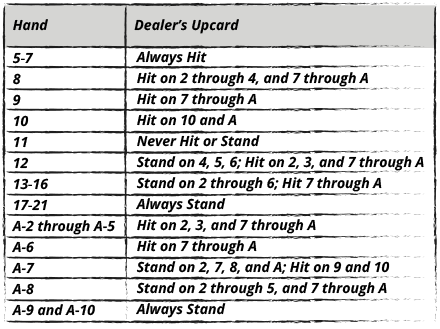
Single Deck, S17, DAS
Hitting and Standing Pairs
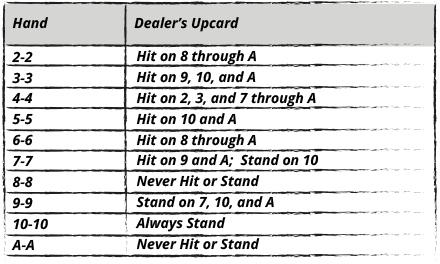
Single Deck, S17, NDAS
Hitting and Standing Pairs
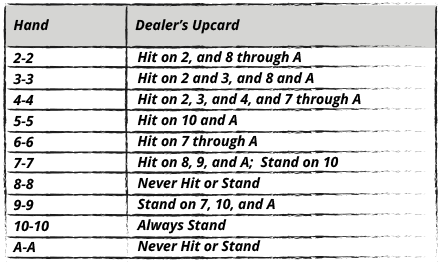
Single Deck, S17
Hitting and Standing Hard and Soft Hands
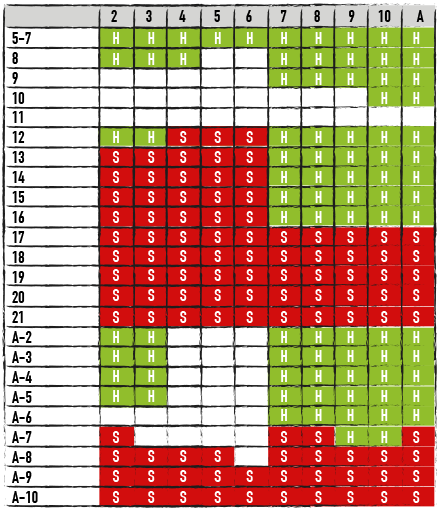
Single Deck, S17 and DAS
Hitting and Standing Pairs
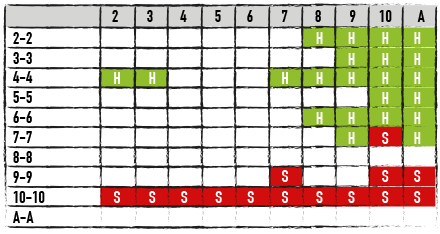
Single Deck, S17, NDAS
Hitting and Standing Pairs
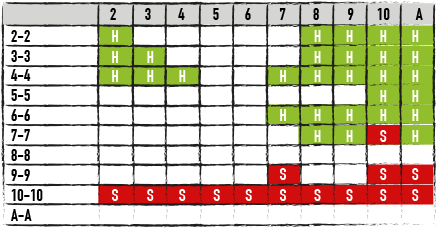
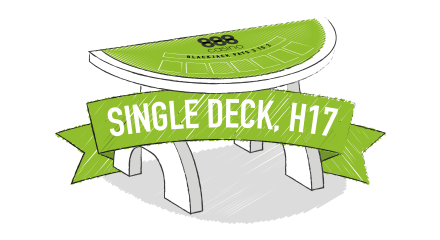
Single Deck, h27
Hitting and Standing Hard and Soft Hands
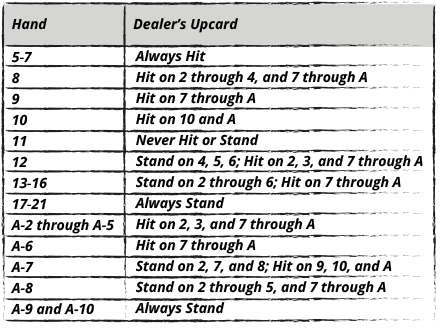
Single Deck, h27, DAS
Hitting and Standing Pairs
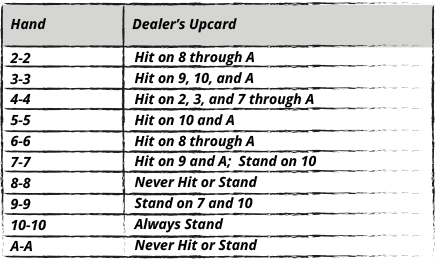
Single Deck, h27, NDAS
Hitting and Standing Pairs
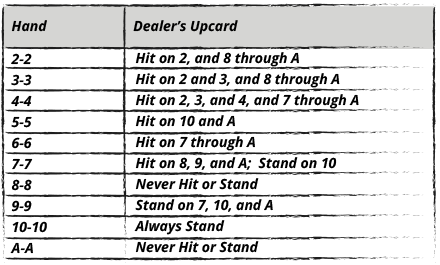
Single Deck, h27
Hitting and Standing Hard and Soft Hands
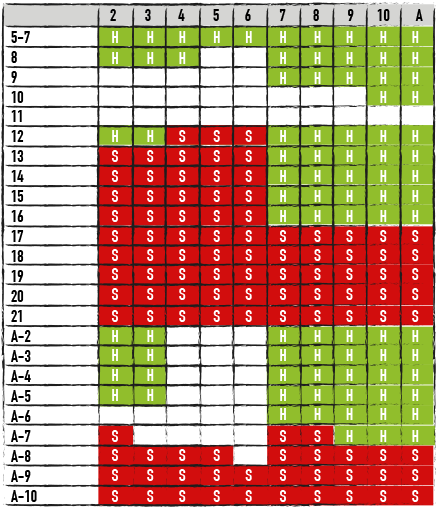
Single Deck, h27 and DAS
Hitting and Standing Pairs
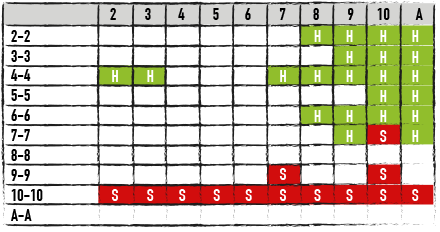
Single Deck, h27, NDAS
Hitting and Standing Pairs
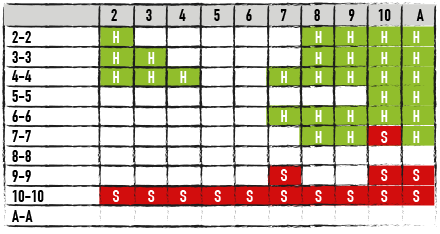
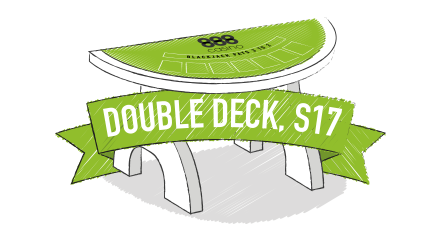
Double Deck, S17
Hitting and Standing Hard and Soft Hands
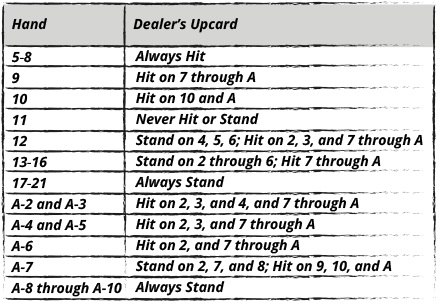
Double Deck, S17, DAS
Hitting and Standing Pairs
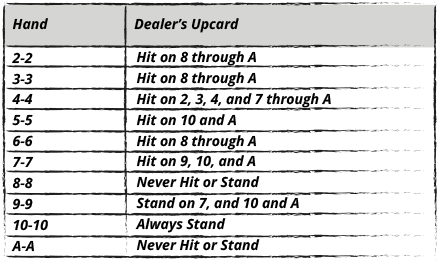
Double Deck, S17, NDAS
Hitting and Standing Pairs
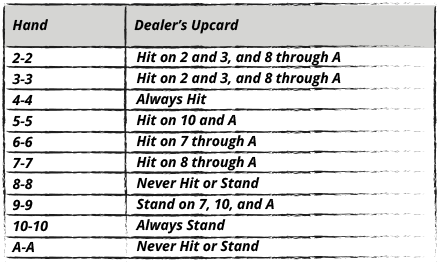
Double Deck, S17
Hitting and Standing Hard and Soft Hands
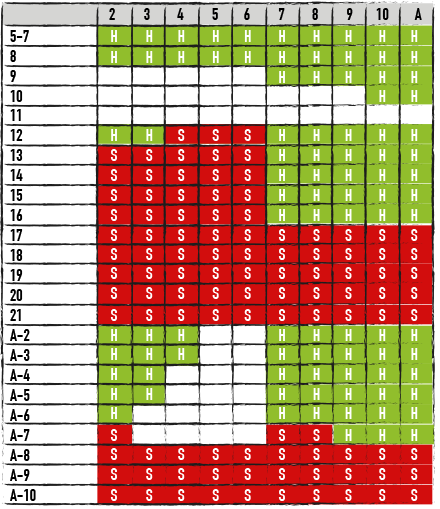
Double Deck, S17 and DAS
Hitting and Standing Pairs
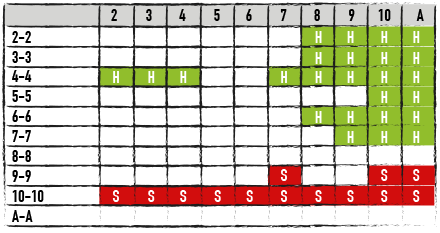
Double Deck, S17, NDAS
Hitting and Standing Pairs
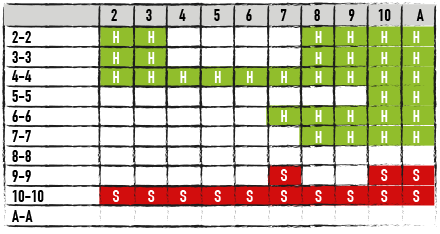
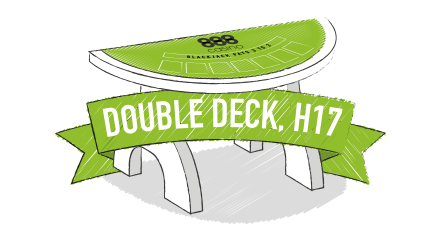
Double Deck, h27
Hitting and Standing Hard and Soft Hands
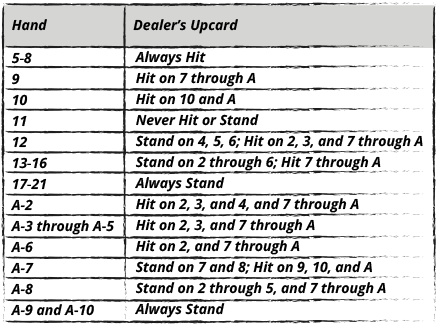
Double Deck, h27, DAS
Hitting and Standing Pairs
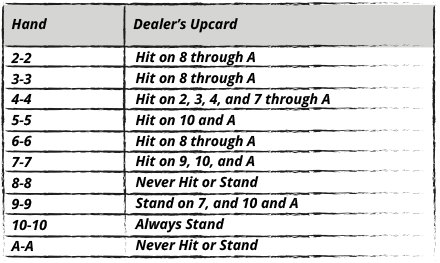
Double Deck, h27, NDAS
Hitting and Standing Pairs
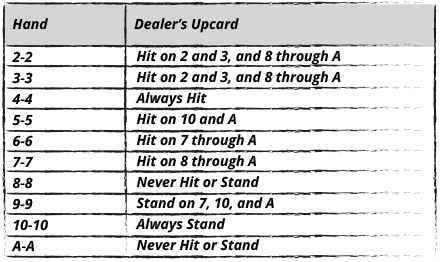
Double Deck, h27
Hitting and Standing Hard and Soft Hands
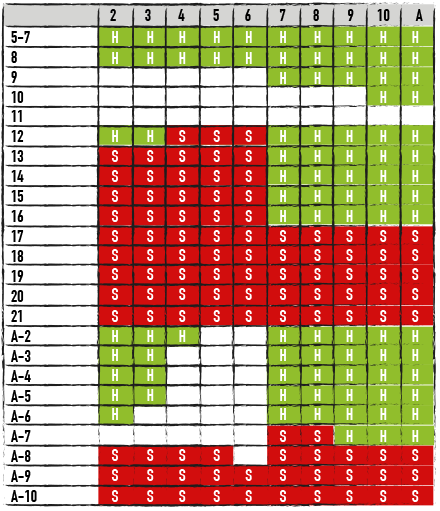
Double Deck, h27 and DAS
Hitting and Standing Pairs
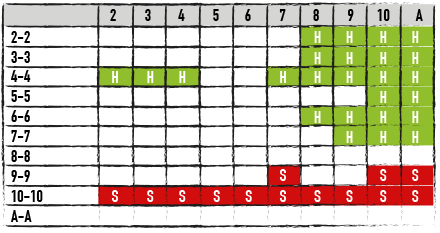
Double Deck, h27, NDAS
Hitting and Standing Pairs
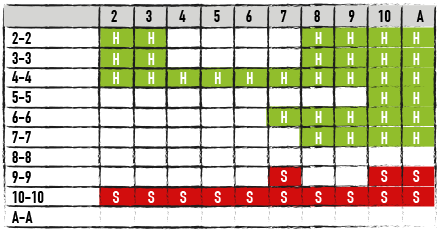
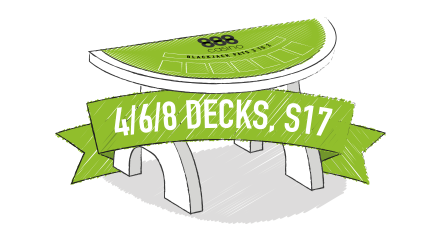
4/6/8 Decks, S17
Hitting and Standing Hard and Soft Hands
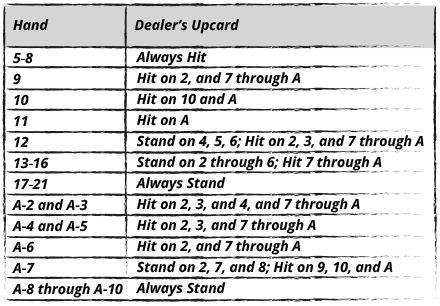
4/6/8 Decks, S17, DAS
Hitting and Standing Pairs
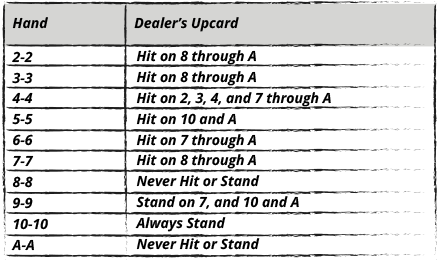
4/6/8 Decks, S17, NDAS
Hitting and Standing Pairs
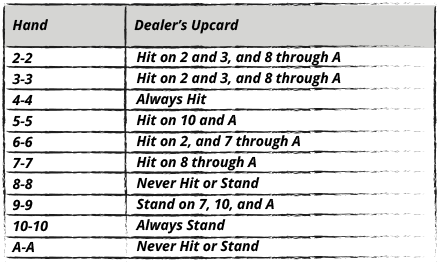
4/6/8 Decks, S17
Hitting and Standing Hard and Soft Hands
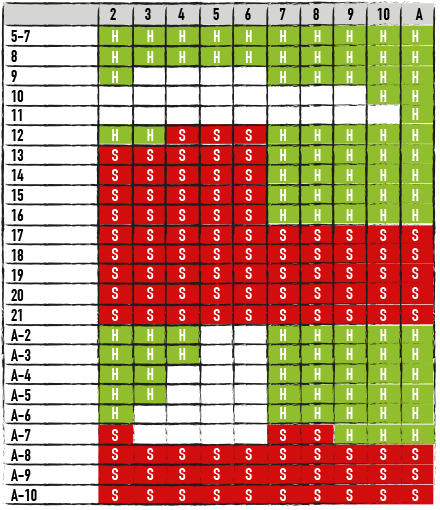
4/6/8 Decks, S17 and DAS
Hitting and Standing Pairs
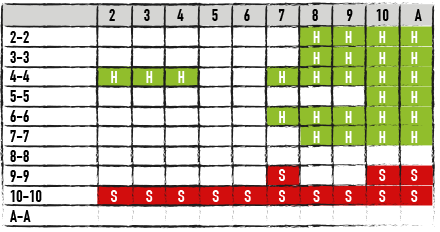
4/6/8 Decks, S17, NDAS
Hitting and Standing Pairs
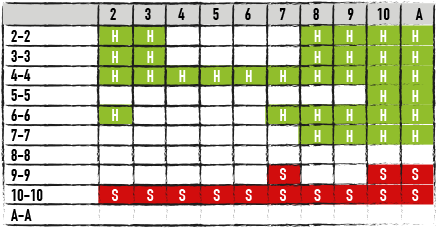
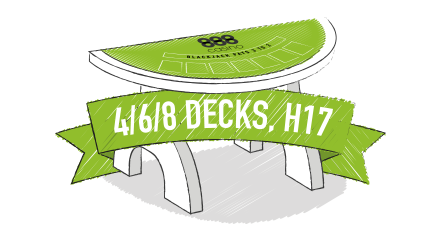
4/6/8 Decks, h27
Hitting and Standing Hard and Soft Hands
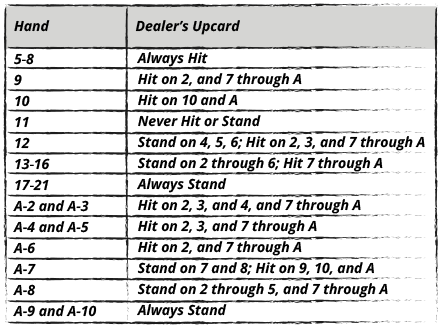
4/6/8 Decks, h27, DAS
Hitting and Standing Pairs
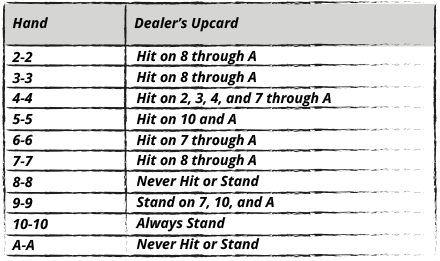
4/6/8 Decks, h27, NDAS
Hitting and Standing Pairs
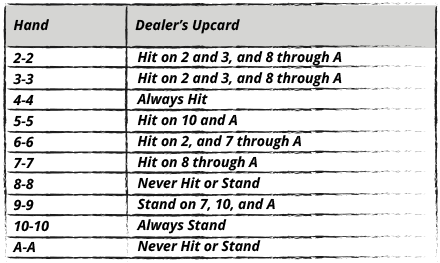
4/6/8 Decks, h27
Hitting and Standing Hard and Soft Hands
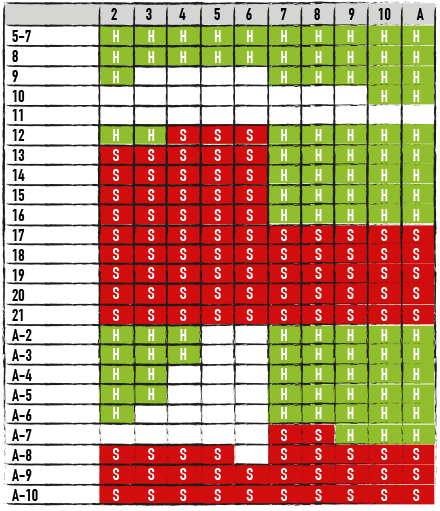
4/6/8 Decks, h27 and DAS
Hitting and Standing Pairs
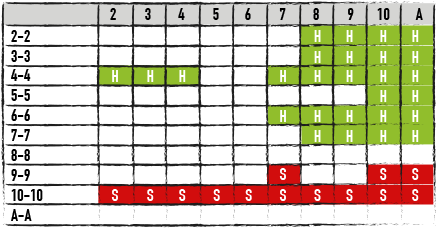
4/6/8 Decks, h27, NDAS
Hitting and Standing Pairs
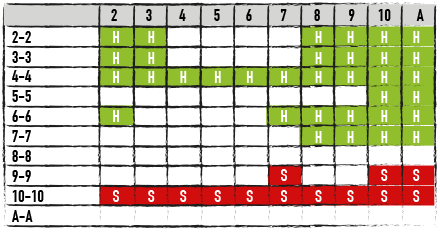
EXAMPLES OF HOW TO USE THE TABLES
- Single-deck game with h27, you hold 16 and the dealer’s upcard is a 7. You should hit.
- Single-deck game with h27 and NDAS, you hold A-7 and the dealer’s upcard is a 9. You should hit.
- Double-deck game with s17 and DAS, you hold a pair of 9s and the dealer’s upcard is a 7. You should stand.
- Eight-deck game with s17, you hold a 12 and the dealer’s upcard is a 3. You should hit.
- Single-deck game, h27 and NDAS, you hold 4-4 and the dealer’s upcard is a 4. You should hit.
- Double-deck game with S17, you hold A-6 and the dealer’s upcard is a 2. You should hit.
LOGIC FOR HITTING AND STANDING ON HARD HANDS
The most common mistake made by novice blackjack players is to always stand on their stiff hands because they are afraid to bust. Stiff means a hand that can be busted by a one-card draw; for example a hard 12 through 16. However, this is a big mistake when the dealer’s upcard is a 2 through 6. Since you know the dealer must hit stiff hands by the rules of the game, you should:
- Not risk busting your stiff hand (resulting in an automatic loss) when the dealer’s upcard is 2-6 because she may end up with a stiff hand
- Instead, stand pat, let the dealer draw, and hope she busts
There is one exception to this rule and that’s when you are dealt a 12 and the dealer’s upcard is a 2 or 3. That’s because the dealer is not as weak with a 2 or 3 upcard, as her bust frequency is lower (35% and 37% respectively) compared to when her upcard is a 4, 5, or 6 (40%, 43%, and 42% respectively). Consequently, the percentages are slightly better for:
- Hitting a hard 12 against a dealer’s 2 and 3 upcard rather than standing.
When the dealer shows a 7 through A upcard, there is a strong likelihood she will end up with a pat hand (i.e., a 17 through 21). Therefore, when you hold hard 16 or less, and surrendering, pair splitting, or doubling is not an option, the percentages are better if you hit your hand even at the risk of busting until you achieve at least a hard 17.
LOGIC FOR HITTING AND STANDING ON SOFT HANDS
Many novice players stand on soft 17 (A-6) thinking that’s a good total, but this is another big mistake. That’s because you can’t bust with a one-card draw to a soft 13 through 17; therefore it’s worth hitting to try to get to hard 17 or soft 18 or higher.
As a general rule, you should never stand on soft 13 through soft 17. You are either going to double down per the doubling strategy summarized in section 2.4, or hit. Your goal is to get to hard 17 or soft 18 to 21, with one exception. When you hold a soft 18 and the dealer shows a strong 9, 10, or A upcard, the percentages are slightly in your favor to hit (rather than stand) on soft 18. Exception: occasionally, depending on rules, you stand on A-7 vs. A.
Here’s another important point to keep in mind about soft hands. Oftentimes your soft hand will be converted to a hard hand when you hit. For example, suppose you have an A-4 and the dealer shows a 7 upcard. You hit and draw a 10. You’ve converted a soft 15 into a hard 15. Now you must switch and use the hard hand standing/hitting rules, which for hard 15 against a 7, is to hit until you get to 17 or more.
MATH OF HITTING AND STANDING
Let’s look at the math for one hand so you will understand why the basic strategy says to hit some hands and stand on others.
Suppose you are dealt a 12 against a dealer 2 (six-deck game with s17). The percentage of the hands that you stand to win or lose is:
- If you stand, you’ll win 35.2% of the hands and lose 64.8%, on average (excludes ties).
- If you hit, you’ll win 37.4% of the hands and lose 62.6%, on average (excludes ties).
Using either strategy, you will be a net loser: 29.6% for standing and 25.2% for hitting.

Let’s assume you wagered $10 per hand.
- After 100 hands, in which you stand on 12 each time, you’d lose about $29, on average.
- After 100 hands in which you hit your 12 each time you’d lose about $25, on average.

So what would you rather do: lose $29 per $100 bet by standing or $25 per $100 by hitting? I hope you agree that hitting 12 against a dealer 2 is a better play (monetarily) than standing, which is why the basic playing strategy states to “Hit 12 against dealer’s upcard of 2.”
I’LL PLAY BY THE DEALER’S RULES
I’d be remiss if I didn’t say something about players who “mimic” the dealer’s rules when they play blackjack; namely, they always hit on 16 or less, always stand on 17 or more, and never double down or split (because the dealer doesn’t). This is a terrible strategy that results in roughly a 5% house edge against you, that’s about 10-times greater than the house edge using the basic playing strategy discussed in this chapter. Fuhgeddaboudit!
If a casino offered you this proposition, would you take it?
You can play blackjack for the rest of your life and they will give you an automatic 18 on every hand.
Would you accept this proposition?
Most players would because they believe that an 18 surely has to be a winning hand in blackjack. Guess again, because:
- Overall you'll end up with a net loss of 0.6% on all the hands (i.e., overall an 18 is a losing hand).
This is what makes blackjack a tough and sometimes frustrating game. You play by the book yet you still end up with a losing session. It happens because for many of the hands you will be dealt, more so the hard hands discussed in this section, you are, unfortunately, the underdog no matter what playing strategy you invoke. Still, as I’ve mentioned several times (and I hope it sinks in), your best strategy is to:
- Always follow the basic playing strategy because in the long run, you’ll lose less when you are the underdog and win more when you are the favorite than with any other playing strategy.
Next up are the insurance and even-money propositions. Should you make those bets? Stay tuned.
BLACKJACK INSURANCE & EVEN MONEY STRATEGY
In this section, I’ll discuss the insurance (and even money) bet. They are side bets introduced into the game of blackjack to give the perception to players that they will protect their hand against a dealer blackjack. You’ll be making the decision on the insurance (or even money) wager even before you decide whether to surrender, double down, split, hit, or stand.
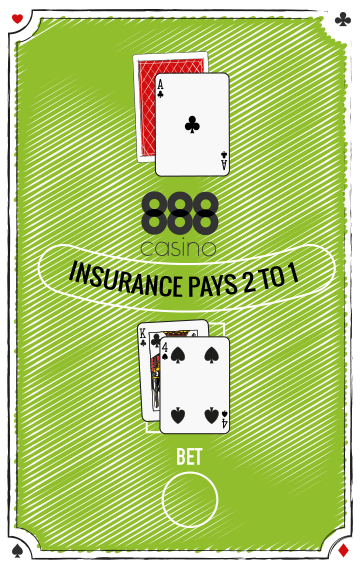 CASINO RULES FOR INSURANCE
CASINO RULES FOR INSURANCE
Whenever the dealer shows an ace upcard, the dealer will ask the players if they want to make the insurance bet. It’s an optional and separate bet in which the player is betting that the dealer’s hole card is a ten or picture card. The amount that the casinos let you wager on the insurance bet is equal to one-half (or less) of the original bet. If the dealer ends up with a ten or picture card in the hole:
- your blackjack insurance bet will win at 2 to 1 odds
(i.e., you win the same amount as your original wager).
If the dealer doesn’t have a ten or picture card, then:
- the insurance bet is lost, and play continues.
Suppose, for example, that you make a $10 bet on your original hand, you do not have a blackjack, and the dealer shows an ace. You decide to make the insurance bet so you place a $5 chip above your original bet on the semicircular line on the layout labeled “Insurance pays 2 to 1.” Let’s assume the dealer checks his hole card and it’s a ten giving him a blackjack. Here’s what happens.
- You lose your original $10 bet on the hand to the dealer’s blackjack but win $10 on the $5 insurance bet. Overall you break even. (If you had not taken the insurance bet, you would have lost your original $10 bet on the hand because the dealer’s blackjack would have beaten you.)
So, isn’t it better to push on the hand by making the insurance bet rather than to lose the entire original bet? Seems logical doesn’t it? But here are the facts about the insurance bet.
- Despite what the casinos would have you believe, the blackjack insurance bet is strictly a side bet that has nothing to do with increasing or decreasing your chances of winning the original bet.
- When you make the insurance bet you are betting solely that the dealer’s hole card is a ten or picture card; you aren’t “insuring” anything.
- It is a sucker bet, worthy of no consideration if you are a smart basic strategy player.
MATH OF BLACKJACK INSURANCE WAGER
In a single deck of cards, we know that the ratio of non-tens to tens is 36 to 16. Assume, after the cards are dealt on the first round, that the dealer is showing an ace and asks if you want to take insurance. If we ignore for the moment the composition of your two cards, then the ratio of non-ten to tens in the unplayed 51 cards is now 35 to 16. This means:
- 35 times that we made a $1 insurance bet, we would lose a total of $35 (the times the dealer wouldn’t have a ten in the hole)
- 16 times, she’d have the ten in the hole and we would win 16 x $2 = $32

Your net loss after making $51 worth of insurance bets is $3.

You disadvantage by making the insurance bet is 5.9%, which is a horrible bet to make.

Let’s now consider the case where the two cards in your hand are non-tens (e.g., a 3-9 or 12) and the dealer shows an ace upcard.
This means the ratio of non-tens to tens in the remaining 49 cards is now 33 to 16, resulting in a net loss of $1 per $49 worth of bets or about 2.0%. This is still a bad bet.

Let’s now consider the case where you are dealt a 20 (two 10s) and the dealer shows the ace. Some blackjack players argue that you should always insure a good hand (like 20) but not a bad hand (like the 12, above). They reason that if you take insurance on a 20, you will avoid losing money on a good hand should the dealer end up with blackjack. And even if the dealer doesn’t have a blackjack, they continue, he’ll still have a tough time beating a 20, so blackjack insurance makes sense.
In fact, taking insurance when you hold a 20 is an even worse bet than taking insurance when you have a “bad hand.” Why?
Because if you are holding a 20 made up of two ten-value cards, you’ve taken out of play two of the cards that the dealer needs for his hole card to have a natural. In the above example, the ratio of non-tens to tens in the remaining 49 cards is now 35 to 14 and you’d end up losing $7 out of $49 worth of insurance bets for a whopping 14.3% disadvantage.

Sorry, but no matter how you look at it, Blackjack insurance is a very bad bet for a basic strategy player and should be avoided.
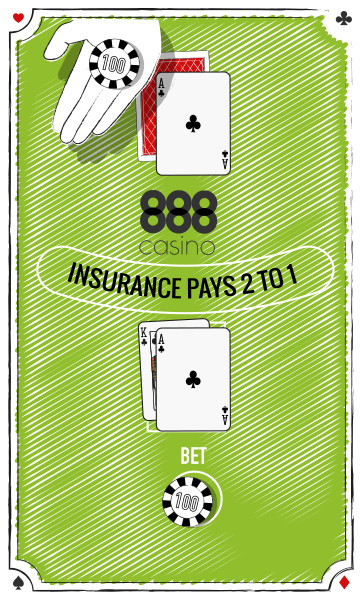 CASINO RULES FOR EVEN MONEY
CASINO RULES FOR EVEN MONEY
Even money comes into play when the dealer shows an ace upcard and you have a blackjack. The dealer will ask you if you want “even money,” and if you say “yes,” she will pay you even money on your wager and remove your cards from play. Notice that will she will pay you even before she looks at her hole card to see if she has a blackjack.
Most players are perplexed when the dealer asks them if they want even money and usually they will ask the dealer or a fellow player for advice on what to do. The response is usually “take the even money because you can’t lose.”
Even money is equivalent to making an insurance bet when you have a blackjack hand. In fact, years ago, there was no such thing as “even money.” If you wanted to insure your blackjack, you made the insurance bet like everyone else.
But then some bright casino executive decided on making it even easier for players that have a blackjack to insure their hand, so he dreamed up the “even money” proposition. The fact that players can be paid even money right on the spot regardless of whether or not the dealer ends up with a blackjack appears too good to be true. Therefore, most players jump at the opportunity to take “even money” when it’s offered to them. After all, it’s an automatic win of one betting unit and you can’t lose even if the dealer ends up with a blackjack. The life of a blackjack player can’t get any better than this. Or, can it?
To convince you what a fool you are for taking even money, let me first convince you that even money is the same as insuring a blackjack hand.
Let’s look at the four possibilities that could occur if you are dealt a blackjack hand and the dealer has an ace upcard.
- 1st Possibility – You take insurance and the dealer has a blackjack.
Result – you push on your blackjack hand but win $10 on your insurance bet. Net result: you win $10. - 2nd Possibility – You take insurance and the dealer doesn’t have a blackjack. Result – you win $15 on your blackjack but lose the $5 insurance bet.
Net result: you win $10. - 3rd Possibility – You pass on the insurance bet and the dealer has a blackjack.
Result – you push and win nothing. - 4th Possibility – You pass on the insurance bet and the dealer doesn’t have blackjack.
Result – you win $15 on your blackjack hand.
If you always insure your blackjack hand (possibilities 1 and 2), you always win even money regardless of the dealer’s outcome. This is why the casinos have reverted to the “even money” proposition when a player has a blackjack hand and the dealer shows an ace. Instead of letting a player go through the motions of making an insurance bet, the casinos will gladly give the player “even money” even before the dealer checks for a blackjack.
The reason most players mistakenly believe you can’t lose when you take even money has to do with the outcome of possibility #3. If you don’t take insurance (or even money) then you risk the possibility that you will win nothing if the dealer has a blackjack. A certain one-unit win is better than no win at all, the reasoning goes, so the masses opt for taking the sure thing – even money.
What most blackjack players fail to realize is that if they don’t take insurance (or even money) and the dealer DOES NOT a blackjack (the more likely scenario), they will win 1.5 times their original bet. So it all boils down to this – is it better to:
- take the sure one-unit win by taking the even money, or
- risk winning nothing some of the time, in order to win 1.5 units some of the time by passing up the even-money proposition?
The experts in the casino pit say to take the sure even-money payoff, rather than risk the possibility of pushing. But here is the rest of the story.
MATH OF EVEN MONEY
When you are dealt a natural and the dealer shows an ace, the dealer will end up with a ten in the hole for a blackjack 15 times out of 49, or about 30.6% of the time, in a single-deck game. Therefore 30.6% of the time you will win even money by insuring your blackjack hand.
However, what if you don’t take insurance?
- Then 30.6% of the times that the dealer has a blackjack you will win nothing (push, meaning no money is exchanged), but
The other 69.4% of the times you will win 1.5 times your bet.
In other words, you are more likely to win 1.5 units by passing up on the even money proposition then you are to push. If you do the math, overall you will average a win equal about to about 1.04 units every time you pass up the even money proposition.

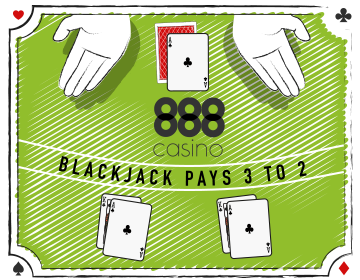 NOW WHICH IS BETTER?
NOW WHICH IS BETTER?- Win 1 unit for certain by taking even money or
- Win 1.04 units on average by declining to take even money.
To put it another way, every time you take even money you’ll be giving up about 4% of your profits. Blackjack is tough enough to beat without giving back your profits to the casinos.
If you are still on the fence about even money, look at it from the casino’s perspective. They know that a player’s natural has an expected value greater than one unit when the dealer shows the ace so they will gladly pay the player only 1 unit for their natural. (Wouldn’t you do the same?)

The bottom line on the insurance bet if you are a
basic strategy player is this:Never insure any hand “good” or “bad” Never take even money when you have a natural
Is there ever a time when the insurance bet ever becomes profitable to the player? The answer is yes and that’s if you are reasonably certain over one-third of the unseen cards are tens and picture cards. The only way you’ll know this is by keeping track of the cards as they are played (i.e., card counting). And I’ll be covering this in Chapter 9 - Frequently Asked Blackjack Questions.

KEY TAKEAWAYS:
- Although millions of players play blackjack, the vast majority of them misplay their hands.
- The basic playing strategy is the most efficient way to play all your hands.
- Players who want to reduce the house edge to less than 1% need to learn the basic strategy for surrender, pair splitting, doubling down, and hitting and standing.
- Surrender is a playing option whereby a player can forfeit his initial hand and automatically lose half of his wager.
- Late surrender is the common form of surrender. You can surrender your hand only after the dealer checks that she doesn’t have a blackjack.
- Early surrender allows you to surrender before the dealer checks for a blackjack. It is more valuable for a player than late surrender but rarely offered.
- The surrender playing strategy allows players to minimize their losses when they are holding a weak hand against a strong dealer upcard (e.g., 16 against a dealer’s 10 upcard).
- The pair splitting strategy allows players to either win more when they are the favorite, loss less when they are the underdog, or turn a losing hand into a winning hand.
- The doubling down strategy gives the player the opportunity to go on the offensive and bet more money when they are the favorite.
- The hitting and standing strategy will allow you to make the best percentage play to minimize your losses and maximize your gains.
- Insurance is a side bet that is offered to players when the dealer shows an ace upcard.
- When you take the insurance bet, you are betting that the dealer has a 10-value card in the hole and a blackjack.
- Payoff for a winning insurance bet is 2 to 1.
- Dealer will offer a player even money when he has a blackjack and the dealer has an ace upcard.
- If the player accepts even money his original bet will be immediately paid off at 1 to 1.
- Even money is the same as insurance.
Written by Henry Tamburin Ph.D.
![]()
TEST YOURSELF
Try answering the following questions based on the information in Chapter 2.
- The basic strategy is a set of rules that tells you the optimal way to play every hand dealt to you when the only information you have is ________________ .
- The five decisions that blackjack players have to make with their hand are ____________________________ .
- The double-bust rule is what gives the casino its built in edge against players. True or False?
- A half a percent house edge means the casino will win, on average, fifty cents for every $100 you bet. True or False?
- What affects the basic playing strategy?
- You should always split 8s and aces. True or False?
- You are playing in a single-deck game with h27 and NDAS (no surrender). How would you play the following hands against the indicated dealer’s upcard?
- 4-4 vs. 5
- 9-2 vs. A
- 10-5 vs. 7
- You are playing a double-deck game with s17 and DAS (no surrender). How would you play these hands?
- A-7 vs. 9
- 6-3 vs 6
- 12 vs. 3
- You are playing a six-deck game with surrender, s17, and DAS. How would you play these hands?
- 9-9 vs. 7
- A-6 vs. 2
- 5-5 vs. 9
- You are dealt a blackjack and the dealer shows an ace upcard. She asks you if you want even money. Should you accept or decline the even money?
Answers
- The basic strategy is a set of rules that tells you the optimal way to play every hand dealt to you when the only information you have is your hand and the dealer’s upcard.
- Surrender, pair splitting, doubling down, hitting, and standing.
- True.
- True.
- The number of decks of cards and the playing rules.
- True.
- a. Double Down b. Double Down c. Hit.
- a. Hit b. Double Down c. Hit.
- a. Stand b. Hit c. Double Down.
- Decline.
![]()
